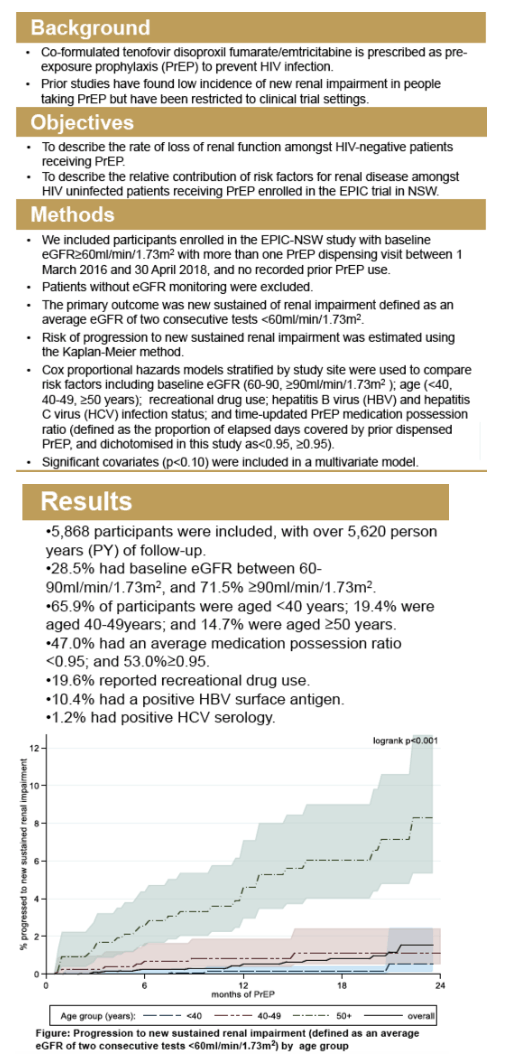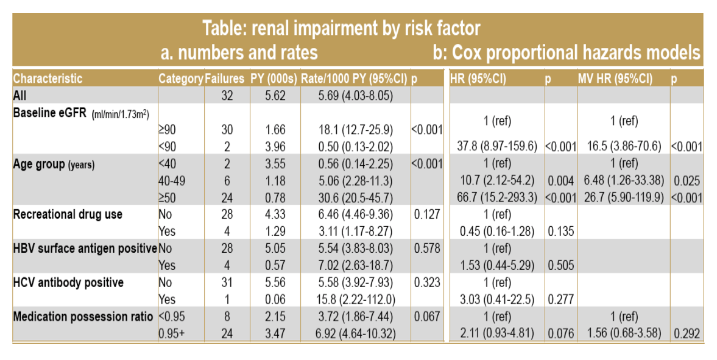 |
 |
 |
| |
RENAL IMPAIRMENT IN A PREEXPOSURE
PROPHYLAXIS IMPLEMENTATION COHORT IN AUSTRALIA
|
| |
| |
CROI 2020
Download the PDF here
Hamish McManusa, Douglas Drakb, Jack E. Heronc, Tobias Vickersa, Stefanie Vacchera, Iryna Zablotskad, Rebecca Guya, Benjamin Bavintona, FengyiJina,
Andrew Grulicha, Mark Bloche, Catherine C O’Connoraand David M Graceyb,c,eon behalf of the EPIC study team
a The Kirby Institute, UNSW Sydney, Sydney, Australia; b University of Sydney, Camperdown, NSW, Australia; Renal Department, cRoyalPrince Alfred Hospital, Camperdown, NSW;
d University of Sydney, Westmead, NSW, Australia; eHoldsworth House Medical Practice, Sydney, NSW, Australia
Abstract
Co-formulated tenofovir disoproxil fumarate/emtricitabine is prescribed as pre-exposure prophylaxis (PrEP) to prevent HIV infection. Prior studies have found low incidence of new renal impairment in people taking PrEP but have been restricted to clinical trial settings. We sought to quantify rates of renal impairment in a large prospective cohort of participants taking PrEP as part of a population-level implementation study in Australia.
Participants enrolled in the EPIC-NSW study with baseline eGFR≥60 ml/min/1.73m2, more than one PrEP dispensing visit between 1 March 2016 and 30 April 2018, and no recorded history of prior PrEP were included. Patients without eGFR monitoring during this period were excluded. Risk of renal impairment (defined as average eGFR of two consecutive tests <60) was estimated using the Kaplan-Meier method. Cox proportional hazards models stratified by study site were used to compare risk factors including baseline eGFR (60-90, ≥90), age (<40, 40-49, ≥50), sex, recreational drug use, and HBV and HCV infection status. Time-updated PrEP medication possession ratio (MPR) was included as a binary independent covariate (<0.95, ≥0.95). Significant covariates (p<0.05) were included in a multivariate model.
Of 9,596 participants dispensed PrEP, 4,514 met the inclusion criteria for this analysis. Most were aged <50 (88%), male (99%), and had baseline eGFR 90 (76%). Baseline eGFR<90 was observed in 55% of participants aged 50 compared to 20% aged <50 (p<0.001). The observed rate of renal impairment was 8.0/1,000 person-years (95%CI: 5.86-10.99) over 4,859 person-years follow-up, with two-year cumulative risk of 1.7% (95%CI: 1.11-2.70) (Figure 1). Renal impairment was highest in patients aged 50 at 44.7/1,000 person-years (95%CI: 30.65-65.16) and two-year cumulative risk of 8.3% (95%CI: 5.35-12.69). The rate of renal impairment was also increased in participants with baseline eGFR<90 (32.0/1,000 person-years [95%CI: 23.20-44.20]) and with MPR0.95 (11.2/1,000 person-years, [95%CI: 7.95-15.72]). A multivariate model showed increased risk associated with age 50 compared to <40 (HR: 12.9 [95%CI: 4.31-38.58], p<0.001) and baseline eGFR <90 (HR: 25.6 [95%CI: 5.99-109.18], p<0.001) after adjustment for MPR (HR: 2.3 [95%CI: 0.96-5.68], p=0.060).
In a large real-world PrEP cohort, risk of renal impairment increased over two years of PrEP, with older patients and those with pre-existing renal dysfunction at significantly higher risk.



|
| |
|
 |
 |
|
|